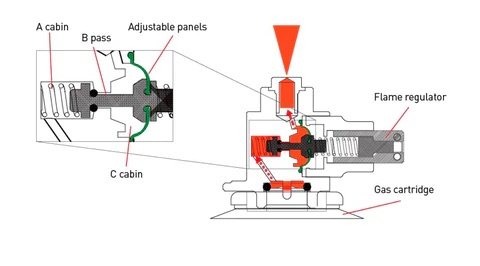What is a pressure regulated stove?
What is a pressure regulator?
The pressure regulator is a system that regulates the pressure of gas output under different environmental conditions.
Why include a pressure regulator?
The pressure of the gas cartridge reduces when
1. In cold environments
2. Used in a continuous output longer than 3 minutes
As a result of weaker pressure, the burner flame becomes weaker. The pressure regulator solves this issue by maintaining a consistent output, resulting in a consistent burner flame.
How does the pressure regulator work?
1. Flame regulator
2. A cabin
3. B pass
4. C cabin
5. Adjustable panels
6. Gas cartridge
I. After opening the valve, gas flows to C cabin through B pass. Adjustable panels regulate the pressure of output via compressing (when the pressure becomes weaker) or enlarging space (when the pressure becomes stronger) in the C cabin.
II. When the pressure inside of the gas cartridge increases rapidly to a high level (for example, the gas cartridge is placed in strong sunlight or incorrectly placed near a heat source), B pass will be closed automatically and the stove will stop working. This enables the pressure regulator to also function as a safety device.
Due to the pressure regulator design, the Polaris is NOT recommended for use with any type of propane bottle other than standard threaded camping gas canisters. The use of adapters will result in poor performance. This includes 1-lb propane bottles, large thread propane tanks, etc.




